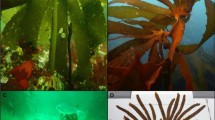Abstract
The epicuticular composition of different body parts of the Cabbage White, Pieris rapae L., was investigated using GC and GC/MS. The major group of components, hydrocarbons, occurs in two distinct classes, which show different distributions on the cuticle of the insects. Unbranched shorter chain compounds (C21 to C31, linear group) dominate on body, head and wings, while longer chain, polymethyl-branched compounds (C35 to C39, branched group) are predominantly found on the antennae. Several other components like 1,3-pentacosadiene and oxygenated aliphatic compounds occur in minor amounts on the cuticle. The reason for this polymorphism is discussed.
Similar content being viewed by others
REFERENCES
Buckner, J. S. Nelson, D. R., and Mardaus, M. C. 1994. The lipid composition of the wax particles from adult whiteflies, Bermisia tabaci and Trialeurodes vaporariorum. Insect Biochem. Molec. Biol. 24:977–987.
Carlson, D. A., Bernier, U. R., and Sutton, B. D. 1998. Elution patterns from capillary GC for methyl-branched alkanes. J. Chem. Ecol. 24:1845–1866.
Francis, G. W. and Veland K. 1981. Alkylthiolation for the determination of double-bond positions in linear alkenes. J. Chromatogr. 219:379–384.
Gibbs, A. G. 2002. Lipid melting and cuticular permeability: New insights into an old problem. J. Insect Physiol. 48:391–400.
Howard, R. W. 1993. Cuticular hydrocarbons and chemical communication. pp. 179–226 in D. W. Stanley-Samuelson and D. R. Nelson (eds.), Insect Lipids: Chemistry, Biochemistry and Biology, University of Nebraska Press, Lincoln, Nebraska.
Kaissling, K. E. 2001. Olfactory perireceptor and receptor events in moths: A kinetic model. Chem. Senses 26:125–150.
Kanaujia, S. and Kaissling, K. 1985. Interactions of pheromone with moth antennae: Adsorption, desorption and transport. J. Insect Physiol. 31:71–81.
Nelson, D. R. and Blomquist, R. J. 1995. Insect waxes: pp. 1–90 in R. J. Hamilton (ed.), Waxes: Chemistry and Molecular Biology and Functions, The Oily Press, Dundee.
Schulz, S. 2001. Composition of the silk lipids of the spider Nephila clavipes. Lipids 36:637–647.
Young, H. P., Larabee, J. K., Gibbs, A. G., and Schal, C. 2000. Relationship between tissue-specific hydrocarbon profiles and lipid melting temperatures in the cockroach Blattella germanica J. Chem. Ecol. 26:1245–1263.
Author information
Authors and Affiliations
Corresponding author
Rights and permissions
About this article
Cite this article
Arsene, C., Schulz, S. & Van Loon, J.J.A. Chemical Polymorphism of the Cuticular Lipids of the Cabbage White Pieris rapae . J Chem Ecol 28, 2627–2631 (2002). https://doi.org/10.1023/A:1021474820601
Published:
Issue Date:
DOI: https://doi.org/10.1023/A:1021474820601




